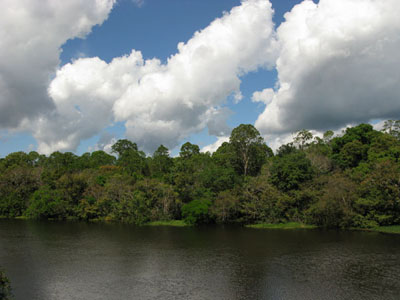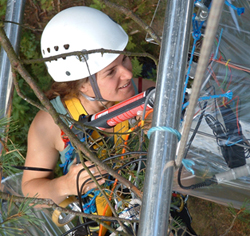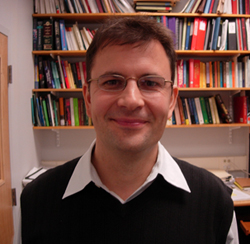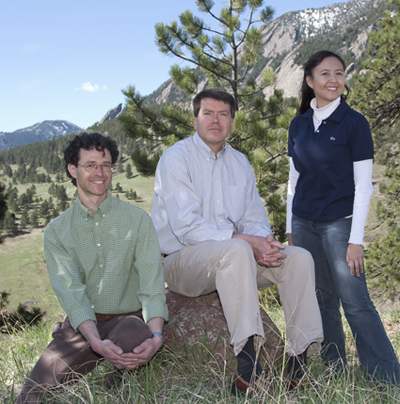The forest and the trees
Will new models of land cover reveal the fate of tropical forests?
Jun 8, 2010 - by Staff
Jun 8, 2010 - by Staff
9 June 2010 • During the stormy summer of 2005, hurricanes Katrina and Rita brought torrential rains and catastrophic damage to the U.S. Gulf Coast, raising concerns about the potential effects of global warming on tropical cyclones. At the same time, a less publicized but equally worrisome climatic story unfolded thousand of kilometers to the south, where the Amazon rainforest was experiencing one of its most intense droughts of the last century.
The drought kindled concerns that had been smoldering for years. Rainforests are often called “the lungs of the planet,” and with good reason. In the Amazon alone, old-growth forests cycle through an average of 18 billion metric tons of carbon annually through photosynthesis and respiration—more than twice the amount emitted globally by human activities. In most years, the Amazon takes up a significant amount of carbon. If recurring drought were to harm these planetary lungs, the consequences for Earth’s climate could be severe.
 Amazonia includes the world’s largest river as well as vast rainforests on either side of it. (Photo by William Bradford.)
Amazonia includes the world’s largest river as well as vast rainforests on either side of it. (Photo by William Bradford.)
Humans aren’t helping. The Kyoto Protocol and other global and regional agreements have done little thus far to stem the tide of rainforest clearcutting for livestock and agriculture. A multibillion-dollar fund for rainforest protection launched at the 2009 Copenhagen climate summit shows promise in controlling the loss, but trees continue to fall at a devastating pace.
Climate models that incorporate land-surface processes have stoked fears about the rainforest. A UK Met Office Hadley Centre simulation led by Peter Cox (University of Exeter), one of the first such simulations to include an interactive carbon-climate cycle, produced a bombshell conclusion published in Nature in 2000: the eastern Amazon rainforest was so drought-vulnerable that climatic shifts over the next century could destroy the bulk of it. Subsequent work has added nuance to the picture, with not all models agreeing on strong drying and warming across the eastern Amazon. However, many scientists remain deeply concerned about the risk of drought-related damage to tropical rainforests.
At NCAR, Amazonian drought has become a focus of both research and development involving the Community Climate System Model (CCSM) and its Community Land Model (CLM) component. There’s also been a lively debate among observational researchers and ecologists over exactly what happened to the Amazon’s vast canopy of trees when the 2005 drought struck (see below).
Fitting vegetation into software
“How do you represent the birth, growth, and death of individual plants?” asks NCAR’s Gordon Bonan. “Ultimately, that’s what an ecosystem is—the sum total of individual plants interacting with each other and the soil environment.”
Bonan has been at the center of land-surface model development for years. He heads the CLM team at NCAR and is embarking on a third edition of Ecological Climatology, the discipline’s leading textbook. He knows how challenging it is for land models to get everything right when it comes to drought.
The idea that losing tree cover could help push a rainforest toward a hotter, drier grassland makes intuitive sense. Climate models have shown that rainforests have a net cooling and moistening effect, as they trap precipitation and release it gradually. The big questions are how much drought it takes to trigger widespread tree loss, and what emerges in the aftermath of that loss.
Version 4 of the CLM, which debuted in April with the release of two new community models (see page XX), tends to reduce the Amazon’s photosynthesis almost immediately when soils dry out. However, observations from flux towers and other sensors indicate that a rainforest actually can carry on with high rates of photosynthesis for a year or more after a drought begins.
 In order to simulate drought, a 2002 experiment in northeast Brazil surrounded trees with rain-blocking panels. (Photo by Matt Williams, University of Edinburgh.)
In order to simulate drought, a 2002 experiment in northeast Brazil surrounded trees with rain-blocking panels. (Photo by Matt Williams, University of Edinburgh.)
“Clearly, something is going on to sustain these rates of photosynthesis,” says Bonan. However, he adds, since a drought-stressed plant can’t live forever, whatever the model is missing may not be changing its eventual outlook. “It’s not clear if this model deficit affects the long-term sustainability of the Amazon,” Bonan says.
Imperfect as it is, land modeling has made great leaps forward. By the mid-1980s, global climate models were explicitly depicting forest canopies, as well as the hydrologic, radiative, and turbulent processes playing out in and near the canopy. Only a few years later, models began to incorporate the physiology of tree leaves and needles—for example, the temperature-dependent rates at which they take up and release carbon dioxide and moisture.
These ingredients went into the creation of today’s state-of-the-art models of dynamic global vegetation (DGVMs), which allow plant types to shift interactively with climate. NCAR’s new CLM includes a dynamic vegetation option (see below). One of the earliest DGVMs, produced by the Hadley Centre, led to the blockbuster finding on the Amazon’s potential fragility in the face of warming and drying.
That study in 2000 made a career-shifting impression on ecologist-turned-climate-modeler Rosie Fisher. Now at Los Alamos National Laboratory, Fisher was then in graduate school at the University of Edinburgh. She crafted a master’s thesis on drought modeling in the central Amazon, then went on to complete a[l1] doctoral thesis on drought stress using data from an ongoing rainfall manipulation experiment that started in 2001 at Caixuanã, Brazil. Using plastic panels spread across most of a hectare (2.5 acres) of forest canopy, the experiment artificially blocks roughly half of the rainfall from reaching the soil below.
 Rosie Fisher.
Rosie Fisher.
As published in Global Change Biology in 2007, the study found that a 50% reduction in moisture reduced the forest’s carbon uptake from the atmosphere by about 10 to 15% over a year’s time, but the trees’ water use decreased by as much as 80% during the most intense periods of drought.
“Just understanding these carbon and water fluxes doesn’t really tell us whether the Amazon will die or not,” notes Fisher. “We need to know how long trees can cope with these conditions, what eventually triggers their mortality, and whether all of the trees are equally susceptible to drought.” The project did help confirm the notion that modeling root systems, particularly the impact of deep roots, is critical to depicting a forest’s fate in a changing climate.
The fight for life within a grid cell
Increasingly, Fisher has found herself turning to her background in plant ecology. “Vegetation models tend to focus on leaf-scale plant processes that you can go into a lab and measure, then scale to a whole grid cell. The more I worked at simulating whole ecosystems, the more important macro-scale ecology seemed. How do communities of plants assemble themselves?”
Fisher found inspiration in the work of Paul Moorcroft (Harvard University), an ecologist who proposed a new approach to DGVMs called ecosystem demography (ED). “The real problem is that the DVGMs we use currently are highly aggregated,” says Moorcroft. “The models divide up the ecosystems of the world into a series of grid cells, but they then assume that the ecosystem in each grid cells acts like a single plant writ large. In fact, each grid cell contains a heterogeneous ensemble of plants. We know from basic theory that the response of such an ensemble will be different than some simple average plant.”
Moorcroft drew on statistical physics in creating his ED approach. “In physics, you can use the behavior of particles to predict the large-scale properties of a fluid or a gas. In a grid cell, you have billions of plants. As theoretical ecologists, we can treat those as a collection of particles.” The idea is to represent the mixture of plants found within each ecosystem grid cell, with the mixture consisting of individuals from different plant types. Each plant varies by height and by the successional stage at its location. The individuals then battle it out in three dimensions—competing for sunlight, water, and nutrients—and the mix of vegetation evolves organically as a result of the birth, growth, and death of each plant.
 Paul Moorcroft.
Paul Moorcroft.
Today’s global climate models typically replace a declining tropical forest with tropical grassland. Moorcroft’s approach points to other possible futures. “We suspect that while some trees will be adversely affected by rising carbon dioxide and increasing temperatures in the tropics, others will be less adversely affected and might actually do better. The existence of diversity within grid cells could thus be a very important part of resilience within the ecosystem. This could mean that the forest will survive but become a very different kind of forest than the one that is there now.”
Another advantage to the ED model is its scalability, says Moorcroft. “It makes predictions at the large scale but it also says something about what you should see on the ground. That’s very helpful, because it’s fundamentally what we have data on.” This facilitates rigorous testing of ED models against the kind of measurements collected at Caixuanã and elsewhere.
Impressed with Moorcroft’s ED modeling approach, Fisher adopted the technique during a postdoctoral stint at Sheffield University in 2008. There, she added plant types and made ED feasible for use within a global model. However, the technique hit a roadblock when she used it to simulate Amazon rainforests. In work soon to appear in New Phytologist, Fisher found that, over hundreds of years, fast-growing plants eventually outcompete their slower-growing, more drought-tolerant contemporaries, because they produce more seeds and monopolize more light—positive feedbacks that reinforce their dominance. The resulting forests are even more sensitive to drying than those in standard vegetation models. The challenge, she thinks, is correctly specifying the mechanisms by which slower-growing, drought-tolerant trees coexist with their faster-growing, drought-vulnerable competitors.
At Los Alamos, Fisher is now putting together the first version of CLM that will include ED-style plant modeling. It’s too soon to know how well that model will perform, but she plans to use the Amazon’s drought of 2005 as one of the first test cases. “While a full understanding of plant community organization may be beyond our reach for the next few years, we can use the 2005 event to work out which of our ensemble of simulated forests are obviously behaving in the wrong way, compared to reality,” she says.
With ED-based land models still in their early days, they won’t be employed in most of the modeling now being performed in support of the next Intergovernmental Panel on Climate Change assessment, due in 2012–13. “There’s inevitably a lag between the bleeding edge and the IPCC, and it’s a good thing,” says Moorcroft. “The models need to be properly tried and tested before they’re ready for conducting IPCC assessments.
For now, Bonan and his NCAR peers are looking forward to the newly improved CLM and its use in the upcoming IPCC assessment. “We feel very confident in how it’s representing the human land-use and land-cover change variables,” says Bonan.
Bringing a variegated picture of forests into climate models may eventually change our view of future climate, but it’s also influencing the discipline of ecology itself, according to Moorcroft. “The models got a lot of plant physiology into them early on. Ecology’s been on the sidelines. We’re now being asked to do something that ecologists aren’t used to doing—making predictions about the future. If ecology is any good, we’ve got to step up to the plate and start doing that more.”
 NCAR’s Sam Levis and Gordon Bonan are working with Kendra Castillo (Purdue University) on tests of the newest Community Land Model.
NCAR’s Sam Levis and Gordon Bonan are working with Kendra Castillo (Purdue University) on tests of the newest Community Land Model.
Does speed matter when it comes to deforestation impacts?
A graduate student from Purdue University has been putting the latest version of NCAR’s Community Land Model through its paces, simulating the impacts of tropical deforestation on climate. Kendra Castillo spent the past winter in Boulder as a graduate student visitor, one of ten being supported this year by NCAR’s Advanced Study Program for periods ranging from 3 to 12 months.
The project’s focus came naturally to Castillo, a native of the Philippines. “I guess I have a bias because I’m from a tropical country,” she says. According to the United Nations Food and Agriculture Organization, the Philippines has been losing its rainforest at the rate of about 2% per year, one of the highest rates in the world.
With her adviser at Purdue, Kevin Gurney, Castillo is conducting a sensitivity analysis to determine whether the pace of deforestation makes a significant difference in the end result. The project dovetails with a climate-treaty option called “preservation pathways,” put forth by Gurney and Purdue colleague Leigh Raymond. Under this plan, nations would receive credit both for preserving forests and for slowing down the rate at which forests are lost.
A new paper by Castillo and Gurney, now in review, compares the climate feedbacks that result from two different rates of human-induced deforestation, one in line with recent history and the other substantially higher. According to Castillo’s NCAR mentor, Sam Levis, “the hypothesis is that there might be some nonlinearity if you pick a rate in between the extremes. That’s what Kendra is trying with CCSM 4.0.”
Castillo’s study will serve as the first major test of the newest CLM’s dynamic vegetation component. It’s now available to users in a format coupled with interactive carbon and nitrogen, which lends a new realism to the output. Although the dynamic vegetation component wasn’t ready to be used in this year’s IPCC runs, says Levis, those runs are including the interactive carbon and nitrogen with vegetation distributions assigned from satellite products.
Green versus brown: Assessing 2005’s toll on the Amazon
There’s no disputing the distinctive nature of the 2005 Amazon drought. Not only was it unusually intense, it struck an unusual area: the southwest. Most of the region’s droughts studied to date have been linked to El Niño, which tends to reduce rainfall across the northeast Amazon. In 2005, the dryness on the ssAmazon’s other side appeared to be related to warm ocean temperatures across the north Atlantic, which also fueled that year’s hyperactive hurricane season.
Exactly what happened to the Amazon’s vegetation during the drought is an open question. A 2009 study in Science led by Oliver Phillips (University of Leeds) employed data from more than 100 forest plots monitored for 25 years across the Amazon. For the first time in the observing network’s history, a net loss of biomass was recorded—perhaps enough to boost that year’s exceptional growth in global carbon dioxide concentrations. Overall, the study found pockets of high tree mortality coupled with smaller but more widespread declines in growth.
At the same time, two surveys using data from NASA’s Moderate Resolution Imaging Spectroradiometer (MODIS) found that the Amazon landscape didn’t turn significantly browner during the drought. A 2007 Science report by Scott Saleska (University of Arizona) and colleagues found that roughly twice as much area turned greener as turned browner, based on the MODIS Enhanced Vegetation Index (EVI).
The Saleska results were contested by Arindam Samanta (Boston University) in a Geophysical Research Letters paper published in March. After applying a more recent set of adjustments to correct for clouds, smoke, and other aerosols, Samanta and colleagues asserted that greenness levels were similar to that found in previous years, with no evidence for large-scale greening or browning.
Though the two parties disagree on their findings (Saleska is preparing a paper in response to Samanta’s), they agree that more observations are needed. “Passive optical remote sensing of Amazonian forests with instruments like MODIS remains a challenging task due to the prevalence of clouds and aerosols,” says Samanta. Other forms of data are needed as well, notes Saleska, including tower-based cameras that could sense the radiation arriving at canopy tops. “Tropical forests are complex, and there is much yet to be figured out,” he says.